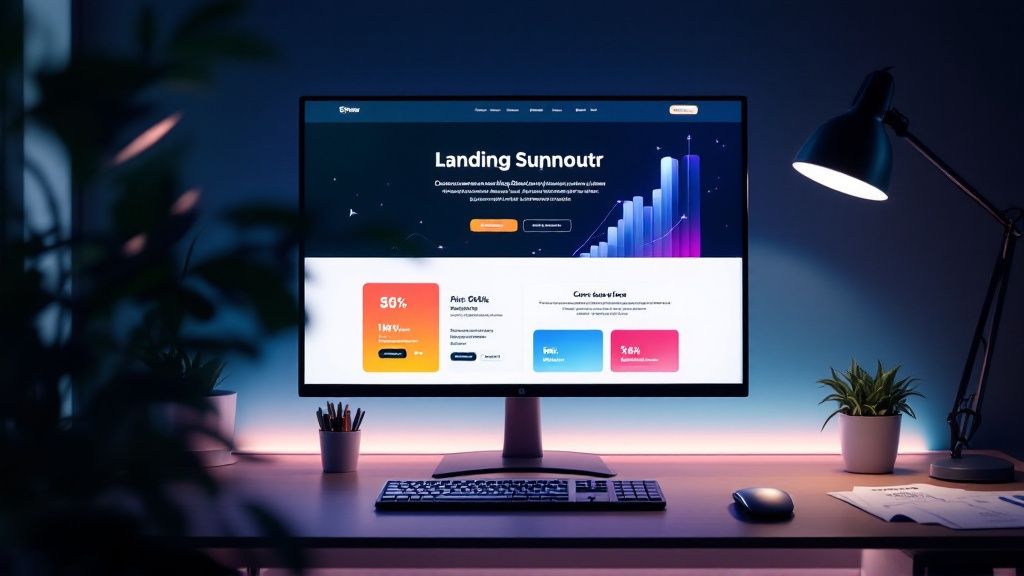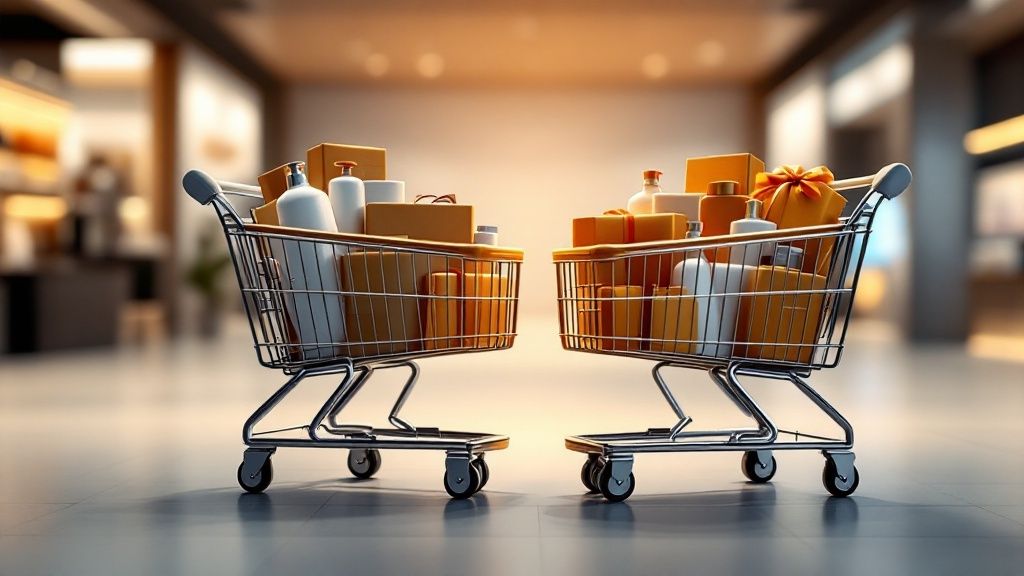Cross Selling vs Upselling: Which Sales Strategy is Right for You?
October 29, 2024

Understanding Cross-Selling and Up-Selling

Although often mentioned in tandem, it's important to distinguish between "cross-selling" and "up-selling" when developing sales strategies. Both aim to increase revenue by encouraging customers to buy more, but they go about it in different ways.
Let's use a simple example: a customer walks into a coffee shop and orders a latte.
- Upselling would be offering them a larger latte, an extra shot of espresso, or a flavored syrup. Essentially, a better version of the same product.
- Cross-selling, however, would be suggesting a pastry, a sandwich, or even a bag of coffee beans to go with that latte – complementary products that enhance their initial purchase.
In short, upselling focuses on increasing the value of a single sale by enticing customers with an enhanced version of what they already want. Cross-selling aims to increase the overall transaction value by offering related items that fulfill additional needs.
Both strategies are effective ways of boosting revenue and improving customer satisfaction, but understanding their differences is key to implementing them effectively.
Benefits and Impact on Business Growth

Why are cross-selling and up-selling so important? In a word: growth. Both offer significant potential to increase revenue, improve customer satisfaction, and strengthen your bottom line. Here's a breakdown of the key benefits:
Cross-Selling: Expanding the Basket
Cross-selling is about introducing customers to products that complement their purchases. This strategy is very effective at increasing average order value and driving revenue growth.
Consider this: if a customer is already buying a laptop, they might also need a carrying case, a mouse, or software. By suggesting these related items, you're not only increasing the value of the sale, but you're also providing a more complete solution for them.
Upselling: Maximizing Value
Upselling, however, focuses on encouraging customers to choose a higher-value version of the product they're already considering. This could mean a larger size, a more advanced model, or additional features.
For instance, a customer looking to buy a basic coffee maker might be swayed by the convenience of a model with a built-in grinder. Upselling increases the profitability of each sale and allows businesses to gain a greater share of the customer's wallet.
Long-Term Impact
Beyond the immediate revenue boost, both contribute to stronger customer relationships and long-term growth:
- Increased Customer Lifetime Value (CLV): Satisfied customers who find value in your suggestions are more likely to become repeat buyers, increasing their lifetime value.
- Enhanced Customer Loyalty: By understanding and fulfilling customer needs beyond their initial purchase, you build stronger relationships and foster a sense of loyalty.
- Reduced Marketing Costs: Selling to existing customers is generally more cost-effective than acquiring new ones. Effective cross-selling and up-selling strategies reduce the need for expensive marketing campaigns.
Implementation Strategies
Knowing the difference between cross-selling and upselling is one thing. Putting these strategies into action is another. Here's a step-by-step guide to effectively implementing both:
1. Know Your Customer
This is fundamental to any successful sales strategy. You need to understand your customers' needs, preferences, and buying behaviour. Use customer data, purchase history, and website analytics to create detailed customer profiles.
2. Identify Relevant Products
This may seem obvious, but it’s crucial to get right. For cross-selling, this means finding products that genuinely complement each other. Think "better together" pairings that enhance the customer experience. For upselling, identify higher-value alternatives within the same product category that offer better features or benefits.
3. Timing is Everything
Don't overwhelm customers with offers the moment they arrive on your site. Instead, present cross-selling opportunities during the checkout process or on product pages of related items. Upselling should happen when a customer is already considering a product, showcasing premium options as a worthwhile upgrade.
4. Make it Personal
Generic recommendations fall flat. Personalize your suggestions based on the individual customer's browsing history, past purchases, and even items in their cart. This shows that you understand their needs and are offering specific solutions.
5. Highlight the Value
Don't just push products – explain how the additional purchase benefits the customer. Emphasize convenience, cost savings, or enhanced enjoyment. For example, instead of just suggesting a laptop bag, highlight its protective features and how it will keep their new laptop safe.
6. Use Visual Cues
A picture is worth a thousand words, especially in online sales. Use high-quality images and even videos to showcase product pairings or demonstrate the benefits of an upsell.
7. Offer Incentives
Sweeten the deal with discounts on bundled products or free shipping for upsells. This can encourage customers to spend a little extra.
8. Don't Be Pushy
There is a fine line between helpful suggestions and aggressive sales tactics. Offer recommendations, but respect the customer's decision if they decline. A gentle approach goes a long way.
9. Track and Analyze
Regularly monitor the performance of your cross-selling and upselling efforts. Track conversion rates, average order value, and customer feedback. Use this data to refine your strategies, identify what's working, and optimize for better results.
Customer Psychology

Effective cross-selling and up-selling strategies depend on understanding the psychological principles that drive customer behavior. By tapping into how customers think and make decisions, businesses can make offers in a way that feels natural, helpful, and ultimately, irresistible.
The Power of Perceived Value
At the heart of both cross-selling and up-selling is the concept of perceived value. Customers are more likely to spend more if they believe they're getting a great deal or enhancing the value of their purchase.
For example: a customer might hesitate to buy a $30 phone case. But, present that same phone case as part of a bundle with a screen protector for $40, and suddenly, it seems like a steal. Similarly, highlighting the added benefits and experience of a premium product can justify the higher price tag.
The Psychology of Scarcity
People tend to place a higher value on things that are scarce or in limited supply. Introducing an element of urgency, such as limited-time offers or low-stock warnings, can encourage customers toward making a purchase they might otherwise have put off.
The Anchoring Effect
The anchoring effect is a cognitive bias that influences how we perceive value. When presented with an initial piece of information, such as a price, we tend to "anchor" our subsequent judgments to that reference point. When up-selling, showcasing a premium product first (the anchor) can make the standard option seem more affordable by comparison, even if it's still pricier than the customer initially planned to spend.
Building Trust Through Personalization
Generic offers can feel impersonal and even off-putting. On the other hand, personalized recommendations based on browsing history, past purchases, or items currently in the cart demonstrate that you understand their needs and are invested in providing a tailored solution. This builds trust and increases the likelihood of a positive response.
Real-World Examples

Let's look at a few examples of cross-selling and up-selling in action:
1. The Streaming Giant: Netflix
Netflix is a master of upselling. While they don't offer different versions of the same streaming plan, they cleverly present their pricing tiers to nudge you towards a higher subscription.
For example: the "Basic" plan might be enough for casual viewing, but the "Standard" plan, with its HD resolution and multiple screens, seems much more appealing when positioned right next to it. They highlight the enhanced value, encouraging you to upgrade for a better viewing experience.
2. The Coffee Colossus: Starbucks
Starbucks excels at both cross-selling and up-selling. When you order a tall latte, they might ask, "Would you like to make that a grande?" That's a classic up-selling technique.
However, Starbucks doesn't stop there. They're also experts at tempting you with pastries, sandwiches, or bags of coffee beans to complement your drink. That warm chocolate chip cookie strategically placed by the register? Pure cross-selling genius.
3. The Everything Store: Amazon
Amazon's entire business model is built on cross-selling and up-selling. Have you ever noticed those "Frequently Bought Together" or "Customers Who Viewed This Item Also Viewed" sections? That's Amazon subtly guiding you towards additional purchases that enhance the value of your initial item.
They're also great at upselling with their "Amazon's Choice" recommendations, which often highlight a slightly more expensive but higher-rated product in the same category.
These are just a few examples of how businesses leverage cross-selling and up-selling to drive revenue and improve customer satisfaction. The main takeaway? These strategies, when used thoughtfully and ethically, benefit both the business and the customer.
Common Mistakes to Avoid
Even with the best intentions, cross-selling and upselling can backfire if not done carefully. Here are some common pitfalls to avoid:
1. Timing is Everything
Imagine a customer adding one item to their cart, and you immediately bombard them with a dozen "You might also like" suggestions. Overwhelming, right? Timing is crucial. Don't interrupt their flow early on. Instead, introduce cross-selling opportunities strategically during checkout or on relevant product pages. Similarly, wait until a customer is engaging with a specific product before introducing upsell options.
2. Irrelevant Recommendations
Suggesting a pair of snow boots to someone shopping for swimwear? Not helpful. Irrelevant recommendations make it seem like you just want their money and damage customer trust. Ensure your suggestions actually complement the customer’s current purchase or browsing history.
3. The Upsell Overload
While tempting, don't go overboard with upselling. Offering too many premium versions can confuse and frustrate customers. Stick to one or two compelling alternatives that offer clear value.
4. Ignoring Customer Signals
Pay attention to how customers respond to your suggestions. Are they hesitant? Do they repeatedly decline? Don't push it! Forcing unwanted products on customers can lead to resentment and lost sales.
5. The "One-Size-Fits-All" Approach
Remember, personalization is key. Generic recommendations are easy to ignore. Leverage customer data to tailor suggestions based on their preferences and purchase history.
6. Forgetting the "Why"
Don't just push products—explain how the additional purchase benefits the customer. Highlight convenience, cost-savings, or enhanced enjoyment. Help them understand the "why" behind your suggestions.
Avoid these mistakes to ensure your cross-selling and upselling strategies enhance the customer experience and drive sustainable revenue growth.
Looking for a tool to help you implement seamless cross-selling and up-selling on your Shopify store? Checkout Links allows you to create custom, shoppable links that lead customers to pre-filled carts, discounted products, and personalized landing pages. Try Checkout Links today and watch your sales soar!
 Checkout Links
Checkout Links



